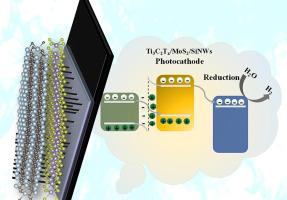Ti₃C₂Tₓ-工程MoS₂/SiNWs多功能光电阴极用于光电化学制氢和废水修复
IF 5.4
3区 化学
Q1 CHEMISTRY, INORGANIC & NUCLEAR
引用次数: 0
摘要
开发高效耐用的光电阴极用于集成制氢和废水处理仍然是光电化学(PEC)系统的关键挑战。这项研究开创了Ti₃C₂TₓMXenes工程MoS₂/SiNWs光电阴极,利用MXenes优越的电荷传输、催化活性和稳定性来解决MoS₂基系统的持续局限性。优化后的Ti₃C₂Tₓ/MoS₂/SiNWs异质结构在0 V时光电流密度为−0.10 mA/cm2,入射光子电流效率(IPCE)为38.12%,几乎是传统MoS₂/SiNWs光电阴极的两倍。对亚甲基蓝(MB)的降解率为80.80%,总有机碳(TOC)降至1.52 mg/mL,在−0.75 V时,析氢速率为9.32 μmol/h。电化学阻抗谱(EIS)显示了102 Ω的超低电荷转移电阻,证实了增强的电荷分离和抑制的复合损失。机理研究建立了S-scheme电荷转移途径,其中Ti₃C₂Tₓ协同促进电子传递,同时促进活性氧(ROS)驱动的有机降解。这项工作通过为同时可持续制氢和环境修复提供可扩展,高效的平台,推进了多功能PEC光电阴极的前沿。本文章由计算机程序翻译,如有差异,请以英文原文为准。

Ti₃C₂Tₓ-engineered MoS₂/SiNWs multifunctional photocathode for Photoelectrochemical hydrogen generation and wastewater remediation
The development of efficient and durable photocathodes for integrated hydrogen generation and wastewater treatment remains a critical challenge in photoelectrochemical (PEC) systems. This study pioneers a Ti₃C₂Tₓ MXene-engineered MoS₂/SiNWs photocathode, leveraging the superior charge transport, catalytic activity, and stability of MXenes to address the persistent limitations of MoS₂-based systems. The optimized Ti₃C₂Tₓ/MoS₂/SiNWs heterostructure demonstrates a remarkable photocurrent density of −0.10 mA/cm2 at 0 V vs. RHE and an incident photon-to-current efficiency (IPCE) of 38.12 %, nearly doubling the performance of conventional MoS₂/SiNWs photocathodes. Additionally, it achieves an 80.80 % degradation of methylene blue (MB), reducing total organic carbon (TOC) to 1.52 mg/mL, while sustaining a hydrogen evolution rate of 9.32 μmol/h at −0.75 V vs. RHE. Electrochemical impedance spectroscopy (EIS) reveals an ultra-low charge transfer resistance of 102 Ω, confirming the enhanced charge separation and suppressed recombination losses. Mechanistic studies establish an S-scheme charge transfer pathway, where Ti₃C₂Tₓ synergistically promotes electron transport while facilitating reactive oxygen species (ROS)-driven organic degradation. This work advances the frontier of multifunctional PEC photocathodes by providing a scalable, high-efficiency platform for simultaneous sustainable hydrogen production and environmental remediation.
求助全文
通过发布文献求助,成功后即可免费获取论文全文。
去求助
来源期刊

Inorganic Chemistry Communications
化学-无机化学与核化学
CiteScore
5.50
自引率
7.90%
发文量
1013
审稿时长
53 days
期刊介绍:
Launched in January 1998, Inorganic Chemistry Communications is an international journal dedicated to the rapid publication of short communications in the major areas of inorganic, organometallic and supramolecular chemistry. Topics include synthetic and reaction chemistry, kinetics and mechanisms of reactions, bioinorganic chemistry, photochemistry and the use of metal and organometallic compounds in stoichiometric and catalytic synthesis or organic compounds.
 求助内容:
求助内容: 应助结果提醒方式:
应助结果提醒方式:


